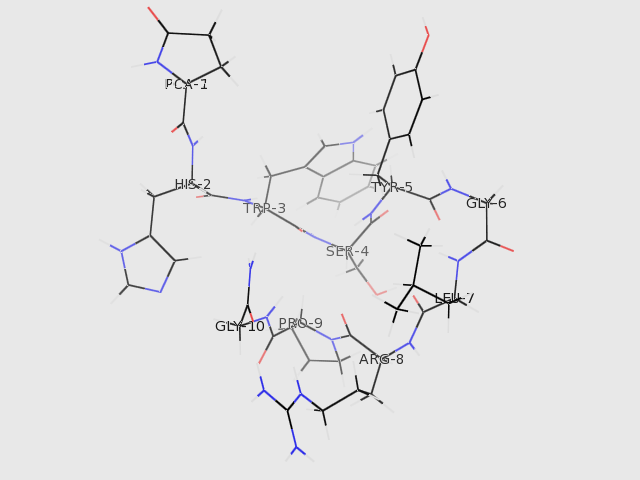Gonadotropin-releasing hormone
| Gonadotropin-releasing hormone | |
|---|---|
 | |
| Identifiers | |
| Symbol | GNRH1 |
| Alt. symbols | GnRH, LHRH |
| Entrez | 2796 |
| HUGO | 4419 |
| OMIM | 152760 |
| RefSeq | NM_000825 |
| UniProt | P01148 |
| Other data | |
| Locus | Chr. 8 p21-11.2 |
Editor-In-Chief: C. Michael Gibson, M.S., M.D. [1] Phone:617-632-7753
Gonadotropin-releasing hormone 1 (GNRH1), also known as Luteinising-hormone releasing hormone (LHRH), is a peptide hormone responsible for the release of FSH and LH from the anterior pituitary. GNRH1 is synthesized and released by the hypothalamus.
Gene
The gene, GNRH1, for the GNRH1 precursor is located on chromosome 8. This precursor contains 92 amino acids and is processed to GNRH1, a decapeptide (10 amino acids) in mammals.
GnRH was previously called LHRH.
Structure
The identity of GNRH1 was clarified by the 1977 Nobel Laureates Roger Guillemin and Andrew V. Schally:
pyroGlu-His-Trp-Ser-Tyr-Gly-Leu-Arg-Pro-Gly CONH2.
GNRH1 as a neurohormone
GNRH1 is considered a neurohormone, a hormone produced in a specific neural cell and released at its neural terminal. A key area for production of GNRH1 is the preoptic area of the hypothalamus, that contains most of the GNRH1-secreting neurons. GNRH1 is secreted in the hypophysial portal bloodstream at the median eminence. The portal blood carries the GNRH1 to the pituitary gland, which contains the gonadotrope cells, where GNRH1 activates its own receptor, gonadotropin-releasing hormone receptor (GNRHR), located in the cell membrane.
GNRH1 is degraded by proteolysis within a few minutes.
Control of FSH and LH
At the pituitary, GNRH1 stimulates the synthesis and secretion of the gonadotropins follicle-stimulating hormone (FSH) and luteinizing hormone (LH). These processes are controlled by the size and frequency of GNRH1 pulses, as well as by feedback from androgens and estrogens. Low frequency GNRH1 pulses lead to FSH release, whereas high frequency GNRH1 pulses stimulate LH release.
There are differences in GNRH1 secretion between females and males. In males, GNRH1 is secreted in pulses at a constant frequency, but in females the frequency of the pulses varies during the menstrual cycle and there is a large surge of GNRH1 just before ovulation.
GNRH1 secretion is pulsatile in all vertebrates, and is necessary for correct reproductive function. Thus, a single hormone, GNRH1, controls a complex process of follicular growth, ovulation, and corpus luteum maintenance in the female, and spermatogenesis in the male.
Activity
GNRH1 activity is very low during childhood, and is activated at puberty. During the reproductive years, pulse activity is critical for successful reproductive function as controlled by feedback loops. However, once a pregnancy is established, GNRH1 activity is not required. Pulsatile activity can be disrupted by hypothalamic-pituitary disease, either dysfunction (i.e., hypothalamic suppression) or organic lesions (trauma, tumor). Elevated prolactin levels decrease GNRH1 activity. In contrast, hyperinsulinemia increases pulse activity leading to disorderly LH and FSH activity, as seen in Polycystic ovary syndrome (PCOS). GNRH1 formation is congenitally absent in Kallmann syndrome.
The GNRH1 neurons are regulated by many different afferent neurons, using several different transmitters (including norepinephrine, GABA, glutamate). For instance, dopamine appears to stimulate LH release (through GnRH) in estrogen-progesterone primed females; dopamine may inhibit LH release in ovariectomized females.[1] Kisspeptin appears to be an important regulator of GNRH release.[2] GNRH release can also be regulated by estrogen. It has been reported that there are kisspeptin-producing neurons that also express estrogen receptor alpha.[3]
GNRH1 in other organs
GNRH1 is found in organs outside of the hypothalamus and pituitary and its role in other life processes is poorly understood. For instance, there is likely to be a role for GNRH1 in the placenta and in the gonads.
Medication
GNRH1 is available as gonadorelin hydrochloride (Factrel) for injectable use. Studies have described it being used via an infusion pump system to induce ovulation in patients with hypothalamic hypogonadism.
Agonists and antagonists
While GNRH1 has been synthesized and become available, its short half-life requires infusion pumps for its clinical use. Modifications of the decapeptide structure of GNRH1 have led to GNRH1 analog medications that either stimulate (GNRH1 agonists) or suppress (GNRH1 antagonists) the gonadotropins. It is important to note that, through downregulation, agonists are also able to exert a prolonged suppression effect.
Template:Pituitary and hypothalamic hormones and analogues
de:Gonadorelin dv:ގޯނާޑޮޓްރޮޕިން ރިލީސިންގ ހޯރމޯން lt:GnRH nl:Gonadotropin-Releasing hormone
- ↑ R.E. Brown. An Introduction to Neuroenocrinology; Cambridge University Press 1994.
- ↑ H. M. Dungan, D. K. Clifton and R. A. Steiner (2006) "Minireview: kisspeptin neurons as central processors in the regulation of gonadotropin-releasing hormone secretion" in Endocrinology Volume 147, pages 1154-1158 PMID 16373418
- ↑ I. Franceschini, D. Lomet, M. Cateau, G. Delsol, Y. Tillet and A. Caraty (2006) "Kisspeptin immunoreactive cells of the ovine preoptic area and arcuate nucleus co-express estrogen receptor alpha" in Neurosci Lett. 2Volume 401, pages 225-230. PMID 16621281